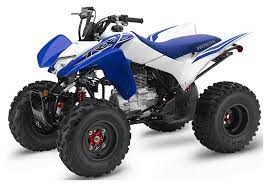No, 400 hours is not a lot for an ATV; instead, hours less than 500 are ideal for an ATV if it is maintained properly.
Before Buying a second-hand ATV vehicle, many people look for the hours the vehicle has covered. It is important as the hours tell how much the engine has worked.
However, we cannot determine the condition of an ATV by only counting the hours.
An ATV that is not maintained properly cannot even survive 300 hours. On the other hand, ATVs that are maintained properly can survive for about 1000 hours.
In addition to the hours, there are other important factors to consider when buying a second-hand ATV vehicle. Such as maintenance, brand, miles/hour ratio, etc.
In this article, we will discuss the average miles/hour ratio for an ATV, average hours for an ATV and the factors that affect the life expectancy of an ATV.
Ideal MilesTo Hours Ratio For An ATV:
As discussed earlier, hours less than 500 are good for an ATV. But what is the ideal miles/hour ratio for an ATV?
The ideal miles-to-hour ratio for an ATV is 15 miles in 1 hour, i.e., a 15:1 ratio.
However, it is equally important to consider the maintenance of the ATV vehicle. Keep your ATV clean, check for any broken parts and store it in a dry and clean place.
If the ATV is not cared for properly, it will wear and tear even with this ideal ratio.
How Many Hours Do ATVs Last On Average?

The life expectancy of an ATV vehicle depends on many factors. Depending on the maintenance, quality, and brand. The ATVs can last from 200 hours to even 1000 hours and more.
An ATV from a cheap brand will not have a good quality material that will be subject to more wear and tear even with fewer hours worked and less distance traveled.
Moreover, if you don’t maintain your ATV properly, don’t clean it, and don’t replace the broken parts, it will not last long and will end up with only 200 hours.
On the other hand, if the ATV vehicle is of high quality, maintained properly, and stored properly, it will last 1000 hours or more.
Your ATV vehicle will require some service once it covers 10,000 miles, but if you maintain your ATV vehicle properly, it will last for about 20 years.
Factors That Affect The Life Expectancy Of An ATV:
If you are concerned about the health of your ATV, you must read these points carefully to keep your ATV in good condition.
1. Maintenance:

It is one of the most important factors to consider when taking steps to extend the life of an ATV.
Like any other thing, ATV vehicles are also required to be maintained. The maintenance includes cleaning it and repairing or replacing the broken parts.
The air filters and exhaust systems of the ATV vehicle get dirty if used in mud and other harsh environments.
No matter how many hours you have ride the vehicle, you must clean the vehicle properly and dry any moisture to avoid further damage.
Moreover, periodically check your vehicle and see if any parts need repair or replacement.
2. Brand:
The ATV bought from a cheap brand will not have good quality and hence will not bear the harsh environment for a long time and suffer more wear and tear.
However, if you buy an ATV vehicle from a well-owned brand, it will be of high-quality material and will not wear and tear early.
Moreover, they will also assist with your vehicle and provide any spare parts, if needed, that will help keep the vehicle in good condition.
3. Riding Style:

The riding style largely affects the life of an ATV vehicle. If the vehicle is extensively used in harsh areas ,for hauling heavy loads,and for racing, it will not last long.
Due to tough work, such vehicles will have a high hourly rate but the low mile. The engine works more than the wheel, putting strain on the vehicle.
On the other hand, the ATV vehicles used for light work such as camping, hunting, and fishing trips will not require the engine to work a lot and hence have more life.
4. Storage Conditions:
ATV vehicles that are not stored properly will suffer problems like dirty carburetors, damaged rubber and metal, and corrosion.
Before storing your ATV vehicle, it is important to remove any dirt and debris from the vehicle as it will stick to the vehicle with time. Moreover, check for any dirt n the air filter and exhaust and clean them properly.
Clean the fuel tank or add a stabilizer; otherwise, once the gas becomes old, it will be broken down into unstable compounds, making the carburetor dirty.
Finally, always store the ATV vehicle in a dry, well-ventilated, and moisture-free room. Also, store it away from the sunlight as the UV rays of the sun can cause damage to the vehicle.
5. Modifications:
Many ATV enthusiasts like to modify their vehicles to increase their performance in rough terrain.
However, these additional modifications to the vehicle will negatively affect the functioning of the remaining parts.
It is possible to upgrade the other parts according to the modifications, but you cannot achieve the longevity of the ATV vehicle with these modifications.
Conclusion:
An ATV work ideally below 500 hours if maintained properly, and so 400 hours are not a big deal. The ideal miles/hour ratio for an ATV is 15:1.
However, it is always important to consider the proper care and maintenance of the ATV vehicle.
A well-maintained and high-quality ATV can last for about 1000 hours or more. On the other hand, ATV vehicles with bad quality and poor maintenance can only survive up to 200 hours.
We have discussed the factors affecting the life expectancy of an ATV vehicle for you. Go and check them out to keep your ATV in a good condition and increase its life.
Also Read
- Will Race Gas Make Me Run Lean In ATV? – Problems
- Will Atv Tires Fit On Car Rims? – Let’s Explore The Facts!
- Will An Engine Crank With No Oil In An Atv?- A Complete Guidance!
- Why Substitute Is Required for the ATV Iso Flex Grease? – Detailed 2023 Guide!
- Why Does The ATV Die When I Give Gas? – Detailed Overview In 2023!
